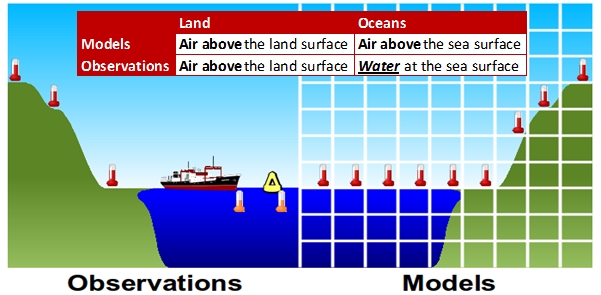A study released earlier this week punches a major hole in a belief commonly held by climate skeptics, which holds that climate models are much too sensitive to increases in CO2 compared to reality. That is to say that climate models are running counter to fact today, in the direction of being too warm, which means any model projection will also be too warm. With this new study, that argument will be much harder to defend.
In the past few years, there has been a divergence in estimates of how much warming we should expect from increasing CO2 that has puzzled scientists and prompted criticisms over how groups like the IPCC or the National Academies weighed new evidence about this critical factor.
The divergence occurred between models and from data. Specifically, estimates of transient climate response (TCR: the warming experienced when atmospheric concentrations of CO2 double over their preindustrial levels) have differed between models and data studies. Climate models say TCR should be about 1.8 °C (1.2-2.4). A series of observational studies over the last few years say that the number should be much less, say 1.3 °C (0.9-2.5). And when policy goals aim to limit warming to 2 °C, half a degree matters.
But a new study, by Richardson et al., finds no evidence that models and the real world respond differently to CO2, when we actually compare like-with-like. This new paper shows that the studies working with data, and the studies working with models, were not actually comparing like-with-like and were therefore actually measuring different things.
It all comes down to how we measure climate sensitivity, which depends on how we measure temperature. In the real world, we have a temperature record which shows about 0.8 °C degrees of warming occurred between 1861-1880 and 2000-2009. Over that period, we know something about how the individual agents that warm and cool the climate (solar forcing, pollution, CO2, and more) have changed. Given the net effect of all of those agents are accounted for, then estimates of TCR go up with a larger increase in temperature.
It is pretty easy to calculate the increase in global average temperature in a climate model. All it takes is a line of computer code. In the real world, it is not so simple. Global average temperature records are constructed from a sparse set of measurements with regional sampling biases (there are not many weather stations in the Arctic Circle) and combine different kinds of temperature measurements (air temperature over land, sea surface temperature over water).
Figure 1: Global temperatures from models are calculated using air temperatures above the land surface and also from the upper few meters of the ocean. Models use the air temperature across all surfaces. Image Source.
Last year, my colleague Thomas Cropper showed that a model-data comparison that did not take this difference into account made models look too hot. That is because the ocean surface temperature increases more slowly than the air temperature above it, and there is not much data in the rapidly warming Arctic. Climate models see the temperature above the sea surface and have full spatial coverage, so they all overestimate warming compared to data products.
This new paper, by Richardson et al., takes the differential sampling into account. They find that if you sample the climate models in the same way that the data was collected, then there is no significant difference in the climate response calculated by models or data, and no evidence that climate models respond more sensitively to increases in CO2 than the real world.
This study poses a major challenge to one of the strongest climate skeptic narratives—that is, that we should expect much less warming than climate models predict. That narrative is the bedrock of many of the arguments used to challenge ambitious climate action from lukewarmists and others, which hinge on lower climate sensitivity, thus implying that we should anticipate less negative effects from climate change.
Interestingly, however, this result does not say that one or the other estimates of climate sensitivity is wrong. Rather, they were just measuring different things—the higher model-based values were applicable to global temperature a few meters above the surface, while the lower data-based values apply to the temperature record represented by our global databases. Resolving the difference turns out to be important.
Richardson et al. note in the paper that climate policy targets, such as the 2 °C goal agreed to in Paris last year, are not specific about what version of temperature they would use as a metric. If it is near-surface temperature, the one represented by climate models, than the Richardson et al. results say we are already 24 percent closer to that marker than is indicated by the ~ 1 °C of warming shown by temperature records. If the goal is to prevent the amalgamation of measurements in the temperature record from breaking 2 °C, then we may have a few more years to reduce emissions.
Either way, the next time someone claims mightily that data tell us that climate models are too sensitive to CO2, know there is much less evidence behind that narrative.
Image by qimono from Pixabay.com
